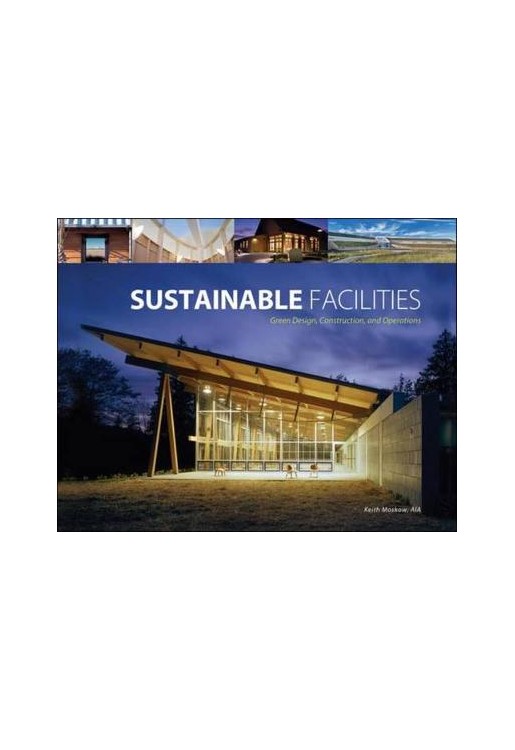Let a Team of Leading Architects Take You through 20 Large-Scale, Sustainable Facilities Designed with Green Methods and Materials!
A vital working tool for all building professionals interested in green architecture and construction, Sustainable Facilities presents an in-depth look at 20 facilities that were designed for environmental organizations and were constructed and now operate using green building methods and materials. Featuring contributions by leading architects in green building, this expert resource examines each building_from planning through operations-- covering new construction, energy-efficient design, operational cost savings, historic preservation, renovation and expansion, land conservation, and LEED ratings. Packed with 200 black & white and full-color illustrations, Sustainable Facilities takes readers through the Woods Hole Research Center... Chesapeake Bay Foundation Environmental Center...Conservation Law Foundation Headquarters... Marion Art and Environmental Center... ...Thoreau Center for Sustainability... California EPA Headquarters Building...Forestech Centre...Institute for Forestry and Nature Research...and many other facilities. This skills-building reference features:
Discussions of 20 facilities_from planning to operationsContributions by leading architects in green buildingAnswers to FAQs about sustainable methods and materialsGuidance on the advantages and obstacles involved with green projectsMethods for weighing up-front costs against operating costs for facilities
Essential for architects, engineers, and contractors, Sustainable Facilities presents state-of-the-art guidance on all the materials, methods, and costs needed for success in green design and building. A groundbreaking resource in the literature of green architecture and construction, Sustainable Facilities offers building professionals everywhere a compelling, in-depth look at 20 facilities that were designed for environmental organizations and were constructed and now operate using green building methods and materials. Written by award-winning architect Keith Moskow, together with a team of leading architects in green building, the book focuses on the unique challenges of each building-from planning through operations-- covering new construction, energy-efficient design, operational cost savings, historic preservation, renovation and expansion, land conservation, and LEED ratings. Sustainable Facilities also explores the advantages and obstacles building teams face on green projects, and explains how to weigh up-front costs against operating costs for facilities. In addition, this cutting-edge reference provides answers to many frequently asked questions about sustainable methods and materials such as:
How did the design process differ from that of a conventional building?Has the building performed up to expectations?Were the initial building costs higher than conventional costs?What effect has the building had on its users?Has the building changed people's perceptions of sustainability?
Filled with 200 outstanding black & white and full-color illustrations, Sustainable Facilities examines a wide range of noted green buildings in the U.S., Europe, and Australia, including:
Woods Hole Research Center (Falmouth, MA) Conservation Law Foundation Headquarters (Boston, MA) Appalachian Mountain Club's Highland Lodge (Crawford Notch, NH)Doyle Conservation Center, (Leominster, MA) Bay Education Center (Providence, RI)Chesapeake Bay Foundation, Philip Merrill Environmental Center (Annapolis, MD)PEEC Visitor Activity Center (Dingmans Ferry, PA)Gwinnett Environmental and Heritage Center (Gwinnett County, GA)World Birding Center (Rio Grande, TX)Kresge Foundation Building (Troy, MI) National Outdoor Leadership School Headquarters (Lander, WY)National Park Service, Carl T. Curtis Midwest Regional Headquarters (Omaha, NE)California Environmental Protection Agency Headquarters (Sacramento, CA) Thoreau Center for Sustainability (San Francisco, CA) IslandWood (Bainbridge Island, WA)Marion Art and Environmental Center (Marion, IA)The Robert Redford Building (Santa Monica, CA) Federal Environmental Agency Headquarters (Dessau, Germany) The Forestech Centre (East Gippsland, Australia) Institute for Forestry and Nature Research (Wageningen, Netherlands)
Authoritative and up-to-date, Sustainable Facilities now equips architects, engineers, and contractors with a state-of-the-art guide to green design, construction, and operations. The reference contains information on materials, methods, and costs that will enable them to take an integrated team approach to green design and building for facilities of all kinds.
Introduction
Chapter 1. Appalachian Mountain Club, Highland Lodge and Education Center, Crawford Notch, New Hampshire
Chapter 2. The Doyle Conservation Center, Leominster, Massachusetts
Chapter 3. Conservation Law Foundation Corporate Headquarters, Boston, Massachusetts
Chapter 4. Woods Hole Research Center, Gilman Ordway Campus, Falmouth, Woods Hole, Massachusetts
Chapter 5. Bay Education Center, Providence, Rhode Island
Chapter 6. Pocono Environmental Education/Visitor Activity Center, Dingmans Ferry, Pennsylvania
Chapter 7. Chesapeake Bay Foundation, Philip Merrill Environmental Center, Annapolis, Maryland
Chapter 8. Kresge Foundation Headquarters, Troy, Michigan
Chapter 9. Gwinnett Environmental & Heritage Center, Buford, Georgia
Chapter 10. Marion Arts and Environmental Center at Lowe Park, Marion, Iowa
Chapter 11. Carl T. Curtis, Midwest Regional Headquarters Building, National Park Service, Omaha, Nebraska
Chapter 12. World Birding Center, Mission, Texas
Chapter 13. National Outdoor Leadership School Headquarters, Lander, Wyoming
Chapter 14. IslandWood, Bainbridge Island, Washington
Chapter 15. The Joe Serna, Jr.--California Environmental Protection Agency (CALEPA), Headquarters Building, Sacramento, California
Chapter 16. The Thoreau Center for Sustainability, San Francisco, California
Chapter 17. The Robert Redford Building for the Natural Resources Defense Council, Santa Monica, California
Chapter 18. Forestech, Baimsdale, Australia
Chapter 19. Federal Environmental Agency, Dessau, Germany
Chapter 20. Institute for Forestry and Nature Research (IBN), Wageningen, The Netherlands


